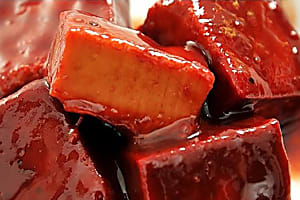In the village of
Usgao, shrouded in anonymity, sits a pile-up of three massive boulders that find link to exotic local lore. A pathway from the
Udiwada ward of the village panchayat of
Usgao-Ganje leads to the site where these rocks lie innocuously amid a verdant surrounding.
People of the area refer to these as 'dhanafatar', which literally translates to mean 'stones of wealth'. Legend has it that beneath these three boulders, all differently sized, lies untold wealth.
And in the tradition of hidden treasures that inspire treasure hunts, the villagers once, long ago, tried to move these black stones to reach the wealth.
"Our ancestors used to tell us that there is treasure underneath these stones.
However, those who attempted to move these stones were said to have become victims of the wrath of the holy spirit of the area," villager Madhu Fondu
Gawde, 60, says.
Possibly the fact that these stones produce a metallic sound on being struck was responsible for the rumours of concealed wealth.
But treasure or no treasure these unique rocks are held sacred by villagers.
Village elder, seventy-year-old Govind
Sadyo Gawde, says, "Our forefathers have been offering their respects to these stone for generations. Before going out during the night, we seek the protection of 'Mandaguru' and 'Dhanafatar' by chanting their names."
Villagers make a bloody offering to appease the spirits of these rocks every year before the onset of the Hindu holy month of Shravan. "On Sunday or Wednesday, we sacrifice roosters at the rocks while invoking 'Dhanafatar'," says Gawde.
Casting back to a time before electricity and torches, when darkness inspired fear and people turned to spirits for protection from the unknown, will give an indication to how these distinctively-shaped stones possibly came to occupy village sensibilities and has eventually come to be revered as
a protector.
The stones sit at a distance of a few metres from the old trade route to
Karnataka, which once must have been surrounded by dense vegetation. Intimidated by the surrounding, even fearing for their lives, travellers' attention must have been drawn to these awe-inspiring boulders beginning the tradition of praying to the stones for their blessings.
If local lore is to be believed, villagers of the area were not the only one to be inspired by these rocks. The belief goes that centuries ago, when the Pandavas passed through the area during their years in exile, they came upon these rocks and were so mesmerised by them that they constructed a temple dedicated to Lord Shiva 300m from the 'Dhanafatar'.
The temple stood on the hillock situated near to 'Kodapyatalo vhal', today only its ruins remain. The idols of Lord Shiva and his vehicle 'Nandi' too have succumbed to the onslaught of time and weather.
"The
Dhanafatar has always been a point of attraction, not only for our villagers but also for the people visiting the spot. The boulders are symbols of our cultural and religious identity. We want to maintain its ethos and don't want to erect any concrete structure around it. Any attempts to do so, we do not support," Gawde says.
 Kerkar monolith
Kerkar monolith Kerkar monolith
Kerkar monolith



